|
The equality operation is used to find out
whether two
values are the same. From the above formula, the SQL interpreter would
compare
Value1 and Value2. If Value1 and Value2
are
the same, the comparison produces a TRUE result. If they
are different, the comparison renders
FALSE.
The equality operation can be illustrated as
follows:
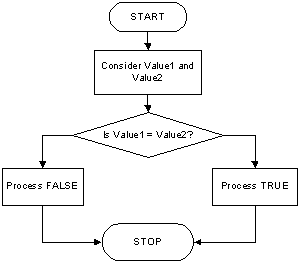
As opposed to equality, to find out if two
values are
not equal, use the <> operator. Its formula is:
Value1 <> Value2
The <> is a binary operator (like all
logical
operators) that is used to compare two values. The values can come
from
two variables as in Variable1 <> Variable2. Upon comparing
the
values, if both hold different values, the comparison produces a TRUE.
Otherwise, the comparison renders
FALSE or a null value.
It can be illustrated as follows:
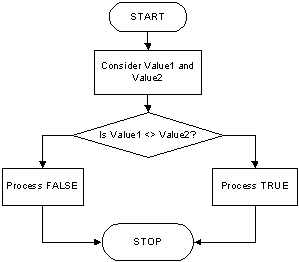
Notice that the Not Equal operator <> is the
opposite
to the Equality operator =.
To find out whether one value is lower than
another,
use the < operator. Its formula is:
Value1 < Value2
The value held by Value1 is compared to that
of
Value2. As it would be done with other operations, the comparison
can be
made between two variables, as in Variable1 < Variable2. If the
value
held by Value1 is lower than that of Value2, the comparison
produces
a true or positive result.
The Less Than operator "<" can be
illustrated as follows:
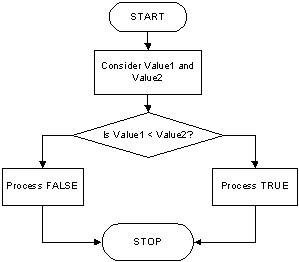
The Equality and the Less Than operators can
be combined to compare
two values. This allows you to know if two values are the same or
if the
first is less than the second. The operator used is <= and its
formula is:
Value1 <= Value2
If both Value1 and Value2 are
the same, the result is
true or positive. If the left operand, in this case Value1,
holds a
value lower than the second operand, in this case Value2,
the
result is still true. If the value of Value1 is strictly higher
than that
of Value, the comparison produces a FALSE result.
A <= operation can be illustrated as
follows:
![Flowchart]()
To find out if one value is strictly greater
than
another, you can use the > operator. Its formula is:
Value1 > Value2
Both operands, in this case Value1 and
Value2, can be
variables or the left operand can be a variable while the right
operand is
a constant. If the value on the left of the > operator is
greater than
the value on the right side or a constant, the comparison produces
a true
or positive value. Otherwise, the comparison renders false or
null.
The > operator can be illustrated as
follows:
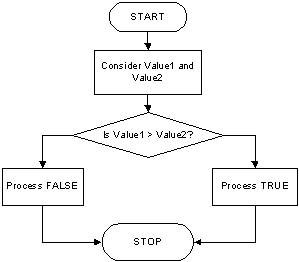
Notice that the > operator is the opposite to
<=.
|
Greater Than or Equal To >= |
|
The greater than and the equality operators
can be
combined to produce an operator as follows: >=. This is the
"greater than or equal to" operator. Its formula is:
Value1 >= Value2
The comparison is performed on both operands:
Value1 and
Value2. If the value of Value1 and that of
Value2 are the same, the
comparison produces a true or positive value. If the value of the
left
operand is greater than that of the right operand, the comparison
produces true or positive also. If the value of the left operand
is
strictly less than the value of the right operand, the comparison
produces
a false or null result. This can be illustrated as follows:
![Flowchart: Greater Than Or Equal To]()
Notice that the >= operator is the opposite to
<.
A condition statement is an expression you formulate
to
evaluate it. Most of the time, the statement is written so that, when
evaluated, it can produce a result of true or false, then, depending on
the
outcome, you can take action. A condition is usually written as simple
as
possible to make it clear to you and the SQL interpreter. Although the
interpreter never gets confused, if you create a difficult statement,
you may
receive an unpredictable result.
In the next few sections, we will review the keywords and
formulas that Transact-SQL provides to help you formulate clear
expressions.
Expressions usually start with a keyword, followed by the expression
itself.
After the expression, you can tell the interpreter what to do. The
statement may
appear as follows:
Keyword Expression
Statement
With the above formula, we will always let you know
what
keyword you can use, why, and when. After the expression, you can write
the
statement in one line. This is the statement that would be executed
if/when the Expression
of our formula is satisfied. In most cases, you will need more than one
line of
code to specify the Statement.
As it happens, the interpreter considers
whatever comes after the Statement as a unit but only the line
immediately after
the Expression. To indicate that your Statement covers
more than
one line, start it with the BEGIN keyword. Then you must use the END
keyword to indicate where the Statement ends. In this case, the
formula
of a conditional statement would appear as follows:
Keyword Expression
BEGIN
Statement Line 1
Statement Line 2
Statement Line n
END
You can still use the BEGIN...END combination
even if
your Statement covers only one line:
Keyword Expression
BEGIN
Statement
END
Using the BEGIN...END combination makes your
code
easier to read because it clearly indicates the start and end of the Statement.
Probably the primary comparison you can perform on a
statement is to find out whether it is true. This operation is performed
using
an IF statement in Transact-SQL. Its basic formula is:
IF Condition
Statement
When creating an IF statement, first make
sure you provide a
Condition expression that can be evaluated to produce true or
false. To
create this Condition, you can use variables and the logical
comparison
operator reviewed above.
When the interpreter executes this statement, it
first
examines the Condition to evaluate it to a true result. If the Condition
produces true, then the interpreter executes the Statement. Here
is an
example:
DECLARE @DateHired As datetime2,
@CurrentDate As datetime2
SET @DateHired = N'1996/10/04'
SET @CurrentDate = N'2007/04/11'
IF @DateHired < @CurrentDate
PRINT N'You have the experience required for a new promotion in this job';
This would produce:
![IF]()
The IF condition we used above is
appropriate
when you only need to know if an expression is true. There is
nothing to
do in other alternatives. Consider the following code:
DECLARE @DateHired As datetime2,
@CurrentDate As datetime2
SET @DateHired = N'1996/10/04'
SET @CurrentDate = N'2007/04/16'
IF @DateHired > @CurrentDate
PRINT 'You have the experience required for a new promotion'
GO
This would produce:
![IF...ELSE]()
Notice that, in case the expression to examine
produces a false result, there is nothing to do. Sometimes this
will
happen.
The CASE keyword is used as a conditional
operator
that considers a value, examines it, and acts on an option depending on
the
value. The formula of the CASE statement is: CASE Expression
WHEN Value1 THEN Result
WHEN Value2 THEN Result
WHEN Value_n THEN Result
END
In the following example, a letter that represents a
student
is provided. If the letter is m or M, a string is created as Male. If
the value
is provided as f or F, a string is created as Female:
DECLARE @CharGender Char(1),
@Gender Varchar(20);
SET @CharGender = N'F';
SET @Gender =
CASE @CharGender
WHEN 'm' THEN 'Male'
WHEN 'M' THEN 'Male'
WHEN 'f' THEN 'Female'
WHEN 'F' THEN 'Female'
END;
SELECT N'Student Gender: ' + @Gender;
GO
Here is the result of executing it:
![CASE]()
|
CASE...WHEN...THEN...ELSE |
|
In
most cases, you may know the only types of value that would be submitted
to a CASE
statement. In some other cases, an unpredictable value may be submitted.
If you
anticipate a value other than those you are aware of, the CASE
statement
provides a "fit-all' alternative by using the last statement as ELSE.
In
this case, the formula of the CASE statement would be: CASE Expression
WHEN Value1 THEN Result
WHEN Value2 THEN Result
WHEN Value_n THEN Result
ELSE Alternative
END
The ELSE statement, as the last, is used when none
of the
values of the WHEN statements fits. Here is an example:
DECLARE @CharGender Char(1),
@Gender Varchar(20);
SET @CharGender = N'g';
SET @Gender =
CASE @CharGender
WHEN 'm' THEN 'Male'
WHEN 'M' THEN 'Male'
WHEN 'f' THEN 'Female'
WHEN 'F' THEN 'Female'
ELSE 'Unknown'
END;
SELECT N'Student Gender: ' + @Gender;
GO
This would produce:
![CASE...WHEN...THEN...ELSE]()
If you don't produce an ELSE statement
but a value not addressed
by any of the WHEN statements is produced, the result would be
NULL. Here is an example:
![CASE...WHEN...THEN...ELSE]()
This means that it is a valuable safeguard to
always include an
ELSE sub-statement in a CASE statement.
To examine a condition and evaluate it before
taking
action, you can use the WHILE operator. The basic formula
of this
statement is:
WHILE Expression
Statement
When implementing this statement, first
provide an Expression
after the WHILE keyword. The Expression must produce
a true
or a false result. If the Expression is true, then the
interpreter executes the
Statement. After executing the Statement, the Expression
is
checked again. AS LONG AS the Expression
is true, it will keep executing the Statement. When or once
the Expression
becomes false, it stops executing the Statement. This
scenario can
be illustrated as follows:
![WHILE]()
Here is an example:
DECLARE @Number As int
WHILE @Number < 5
SELECT @Number AS Number
GO
To effectively execute a while
condition, you
should make sure you provide a mechanism for the interpreter to
get a
referenced value for the condition, variable, or expression being
checked.
This is sometimes in the form of a variable being initialized
although it
could be some other expression. Such a while condition could be
illustrated as follows:
![WHILE]()
This time, the statement would be
implemented as
follows:
DECLARE @Number As int
SET @Number = 1
WHILE @Number < 5
BEGIN
SELECT @Number AS Number
SET @Number = @Number + 1
END
GO
This would produce:
![WHILE]()
Databases and other programming environments
provide
operators you can use to perform data analysis. The
operators used are
called logical operators because they are used to perform
comparisons
that produce a result of true or false (there is no middle
result; in
other words, something is not half true or half false or "Don't
Know": either it is true or it is false).
|
The TRUE and FALSE Constants
|
|
In Boolean algebra, something is considered TRUE
when it holds a value. The value is also considered as 1 or Yes.
By
contrast, if something doesn't hold a value, it is considered
non-existent and non-worthy of consideration. Such a thing has a
value
of FALSE, 0, or No. To retrieve such a value, you can
just find
out if the value of a field is existent or not.
The comparison for a True or False value is
mostly
performed on Boolean fields, such a case is the SPHome (which
specifies
whether a student lives in a single parent home) field of the
Students
table of the HighSchool database. If a record
has a value of 1, the
table considers that such a field is True. If the field has a 0
value,
then it holds a FALSE value.
After you have declared a variable, the SQL
interpreter
reserves a space in the computer memory for it but doesn't put anything
in that
memory space. At that time, that area of memory doesn't hold a
significant
value. Also at that time, the variable is considered null.
Here is note to be careful about: when a variable is
said to
hold a null value, it doesn't mean its value is 0. It doesn't even mean
that the
variable's memory space is empty. It actually means that we cannot
clearly
determine the current value that the variable is holding.
To support the null value, Transact-SQL provides a
constant
named NULL. The NULL constant is mostly used for
comparison
purposes. For example, you can use an IF statement to check the nullity
of a
variable.
To validate something as being possible, you
can use
the IS operator. For example, to acknowledge that
something is NULL, you can use the IS NULL expression.
Here is an example:
-- Square Calculation
DECLARE @Side As Decimal(10,3),
@Perimeter As Decimal(10,3),
@Area As Decimal(10,3);
SET @Perimeter = @Side * 4;
SET @Area = @Side * @Side;
IF @Side IS NULL
PRINT N'A null value is not welcome'
ELSE IF @Side > 0
BEGIN
SELECT @Side AS Side;
SELECT @Perimeter AS Perimeter ;
SELECT @Area AS Area;
END;
ELSE
PRINT N'You must provide a positive value';
GO
This would produce:
![]()
To avoid having a NULL value, you can either
initialize
the variable or you can assign it a value. Here is an
example:
-- Square Calculation
DECLARE @Side As Decimal(10,3),
@Perimeter As Decimal(10,3),
@Area As Decimal(10,3);
SET @Side = 48.126;
SET @Perimeter = @Side * 4;
SET @Area = @Side * @Side;
IF @Side IS NULL
PRINT N'A null value is not welcome'
ELSE IF @Side > 0
BEGIN
SELECT @Side AS Side;
SELECT @Perimeter AS Perimeter ;
SELECT @Area AS Area;
END;
ELSE
PRINT N'You must provide a positive value';
GO
This would produce:
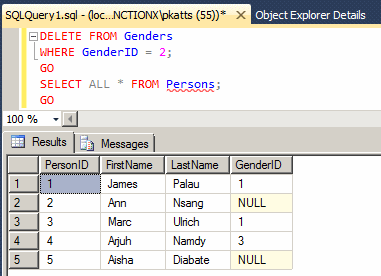
To deny the presence, the availability, or
the
existence of a value, you can use the NOT operator. This
operator
is primarily used to reverse a Boolean value. For example, we
have
learned that FALSE is the opposite of TRUE. In the
same
way, TRUE is the opposite of FALSE. If you want to
compare
a value as not being TRUE, the NOT TRUE would
produce the
same result as the FALSE value. For the same reason, the
expression NOT FALSE is the same as TRUE. |